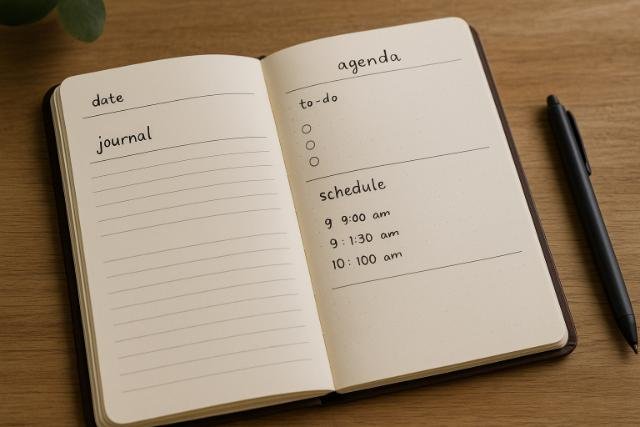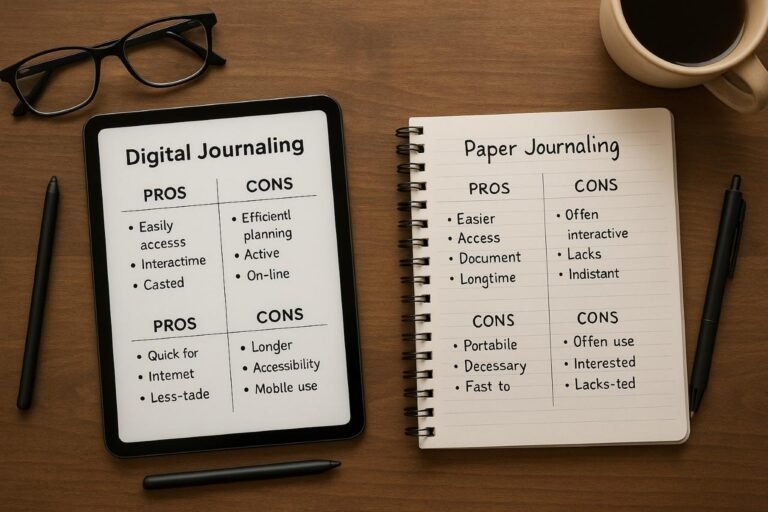Journaling is a timeless art that has evolved dramatically in the digital age. For centuries, individuals have recorded their innermost thoughts, daily experiences, and creative ideas using pen and paper. Today, technology has transformed this reflective habit into a digital process, accessible through smartphones, tablets, and laptops. The modern question is no longer whether to journal, but rather how to journal.
Digital journaling vs paper journaling represents a comparison between convenience and connection between the efficiency of modern tools and the tactile intimacy of handwriting. Each has distinct strengths and weaknesses that influence how we think, feel, and express ourselves. Understanding these differences allows you to choose (or combine) both methods effectively to achieve mindfulness, creativity, and personal growth in your journaling practice.
Identify the Core Purpose Behind Your Journaling Practice
Before choosing between digital or paper journaling, you need to identify what you want to achieve. Journaling is not a one-size-fits-all habit its effectiveness depends entirely on your intentions and emotional goals.
If you journal primarily to organize your thoughts, capture ideas, or maintain productivity logs, then a digital journaling app might suit you best. It allows you to type quickly, categorize entries, and retrieve information instantly. However, if your focus lies in self-reflection, emotional healing, or creative expression, the slower pace of handwriting often deepens introspection and personal connection.
Understanding your motivation also prevents burnout or inconsistency. When journaling aligns with your goals be it mindfulness, productivity, or creativity it becomes a nurturing daily ritual rather than an obligation.
Assess Your Emotional and Mental Goals
Reflect on what you hope to gain emotionally. Are you trying to manage anxiety, explore gratitude, or process personal experiences? Paper journaling enhances emotional awareness by engaging multiple senses sight, touch, and motion that reinforce emotional expression. Writing by hand slows down the thought process, allowing deeper self-awareness and emotional release.
Define Productivity and Creativity Needs
For those using journaling to enhance creativity or manage projects, digital tools provide templates, tags, and search functions that make content retrieval effortless. Digital journaling also supports multimedia integration, letting you attach photos, voice memos, or sketches to complement written reflections. This adaptability makes it ideal for writers, designers, and students.
Evaluate the Key Features of Digital Journaling Tools
Digital journaling merges traditional reflection with modern convenience. Apps and platforms designed for journaling now include advanced features that go far beyond simple text input.
For example, tools like Day One and Journey allow users to insert photos, record voice notes, and sync entries across multiple devices. This makes journaling possible anytime and anywhere, even during commutes or work breaks. Additionally, digital journaling supports auto-sorting and tagging, which help organize thoughts into categories like “gratitude,” “dreams,” or “personal goals.”
Yet, digital journaling isn’t just about efficiency it’s about accessibility. Having your journal available on all devices allows consistent engagement. However, some users report that typing feels impersonal and fast-paced, sometimes reducing the emotional intimacy that handwriting fosters.
Explore Popular Digital Journaling Platforms
Some of the most well-known apps include Penzu, Evernote, Notion, and Daylio. Each provides different strengths. For example, Daylio uses emojis and statistics for mood tracking, while Notion offers flexible templates that integrate journaling with daily planning. Choosing the right platform depends on whether you value simplicity, design, or data-driven insights.
Understand Security and Backup Options
Digital journaling provides enhanced security through encryption, password protection, and cloud backups. Unlike paper journals that can be lost or damaged, digital records remain safe if properly managed. However, users must be mindful of privacy always enable two-factor authentication and avoid public Wi-Fi when accessing personal entries.
Examine the Unique Benefits of Paper Journaling
Paper journaling appeals to those seeking mindfulness and authenticity. The act of physically writing engages neural pathways related to memory, focus, and emotional processing. It’s not just recording words it’s feeling them.
When you write on paper, you disconnect from screens, notifications, and digital fatigue. The texture of paper, the smell of ink, and the visual presence of your handwriting add sensory richness. These elements create a sense of grounding that typing cannot replicate. For many, journaling on paper becomes a meditative act that fosters mental stillness and clarity.
However, paper journaling also involves limitations. It lacks search functions, editing flexibility, and data backups. Losing a notebook can mean losing years of memories. Still, the tangible presence of a filled journal often feels more personal and enduring than digital files.
Choose the Right Journal Type
Your experience can vary depending on the kind of journal you use. Hardcover journals offer durability and aesthetics, while bullet journals are ideal for planners and goal-setters who like structure. Guided journals include prompts that help beginners explore emotions and gratitude more easily. Choosing quality paper and comfortable pens enhances the pleasure of writing.
Incorporate Mindful Writing Rituals
Creating a routine enhances emotional benefits. Light a candle, play calming music, or set aside a quiet corner to write daily. These rituals anchor your mind and body, making journaling a meditative experience rather than a routine task.
Compare Digital vs Paper Journaling Features Side by Side
Each journaling style brings its own functional and emotional rewards. Comparing them directly can reveal which one complements your lifestyle best.
Digital journaling is organized, searchable, and portable perfect for professionals, travelers, or those managing multiple projects. In contrast, paper journaling offers creative freedom, tactile satisfaction, and a screen-free escape.
The table below highlights key comparative aspects to help you visualize the pros and cons more clearly.
| Feature | Digital Journaling | Paper Journaling |
| Accessibility | Syncs across devices instantly | Dependent on physical availability |
| Searchability | Quick keyword and tag search | Requires manual flipping |
| Creativity | Multimedia (photos, links) | Drawing, sketching, collage |
| Emotional Engagement | Slightly reduced due to typing | Deep and mindful connection |
| Privacy | Protected by encryption | Private unless found |
| Distractions | Possible from apps | Minimal to none |
| Longevity | Dependent on tech updates | Timeless physical record |
Balance Convenience with Emotional Engagement
If journaling consistency depends on accessibility, digital platforms may keep you more disciplined. However, if emotional depth matters most, paper journaling may nurture richer reflection. You can also adjust by using a stylus on tablets to imitate handwriting while enjoying digital flexibility.
Customize a Hybrid System
A growing number of journalers combine both systems. For instance, you could write gratitude notes in a paper journal and maintain a digital one for goals or mood tracking. Hybrid systems merge structure and soul, giving you the best of both worlds.
Address the Psychological and Creative Impacts

Your journaling format can influence how your brain processes information, emotions, and creativity.
Writing by hand activates motor skills and brain regions related to comprehension and memory. It slows thinking just enough to enhance focus and awareness, often leading to more meaningful self-reflection. Many people find that handwriting allows them to think “with their hands” a process that promotes emotional healing.
Digital journaling, meanwhile, benefits those who thrive on structure and speed. It allows flexible editing, organization, and multimedia expression. Creative professionals use digital tools to brainstorm visually and track project timelines. However, typing may sometimes make journaling feel more like note-taking than introspection.
Understand Cognitive Processing Differences
Neuroscientific studies reveal that handwriting enhances retention and emotional recall because it engages the sensorimotor cortex. Typing, while faster, activates procedural repetition, leading to less emotional connection. Choosing the right method depends on how your brain best captures meaning.
Explore Journaling’s Role in Mental Wellness
Both journaling methods contribute to mental well-being. Digital journaling aids habit tracking, goal visualization, and progress analysis, while paper journaling enhances self-compassion, gratitude, and emotional balance. Both forms can coexist within mental health routines or therapeutic settings.
Manage the Practical Considerations of Cost, Maintenance, and Sustainability
Journaling also involves practical choices related to cost, maintenance, and environmental impact.
Paper journaling requires buying notebooks, pens, and storage space. Over time, these costs add up, and notebooks take physical space. Digital journaling, in contrast, usually involves a one-time purchase or app subscription, though device maintenance and power use add indirect costs.
Sustainability is another concern. Paper journals consume paper and ink, contributing to deforestation if not recycled. Digital journaling saves trees but increases electronic waste and data-center energy consumption. Thus, eco-conscious users may weigh both sides before deciding.
| Factor | Digital Journaling | Paper Journaling |
| Cost | Free apps to paid subscriptions | Stationery costs |
| Maintenance | Needs backups and updates | Requires physical care |
| Environmental Impact | Energy-intensive servers | Uses paper and ink |
| Accessibility | Unlimited storage | Finite space |
Consider Long-Term Accessibility
Digital journaling ensures continuity over time cloud-based storage prevents data loss and allows instant retrieval from any device. Paper journals, though tangible, can degrade or be misplaced over the years.
Weigh Eco-Friendly Options
For sustainability, use recycled paper or eco-friendly notebooks. If digital, choose low-data apps or solar-powered devices to minimize environmental footprints. Every small choice contributes to sustainable reflection.
Create a Personalized Journaling System That Combines Both

Ultimately, the best journaling system isn’t one or the other it’s one that reflects your personality and habits. Many journalers find that combining both digital and paper approaches provides balance.
For example, you might use a digital journal for daily logs, reminders, and quick ideas, while maintaining a paper journal for gratitude lists, affirmations, or long-form reflections. This method lets you harness digital speed without losing emotional depth.
Hybrid journaling also ensures flexibility. When you’re on the go, use your phone to capture thoughts. At night, unwind with a pen and notebook to process your emotions. Over time, you’ll develop a unique journaling rhythm that adapts to your life’s pace and mood.
Design a Workflow That Fits Your Lifestyle
Identify when and where each journaling type suits you. Use digital journals for daytime productivity and paper journals for evening relaxation. Structuring your journaling habits around your daily routine enhances balance and mindfulness.
Build Habits for Sustainable Journaling
Consistency matters more than format. Set small goals even five minutes daily. Create reminders, protect journaling time, and occasionally review past entries to see how far you’ve come. Journaling, in any form, is about progress, not perfection.
Conclusion
In the comparison between Digital Journaling vs Paper Journaling, the real answer depends on your goals, preferences, and environment. Digital journaling promotes efficiency, accessibility, and technological integration, while paper journaling nurtures mindfulness, emotion, and creativity.
Choosing one doesn’t exclude the other integrating both allows harmony between logic and emotion, modernity and tradition. What matters most is maintaining the habit. Whether you type on a glowing screen or write with ink on paper, journaling remains a deeply personal space for reflection, creativity, and healing a bridge between your inner world and outer life.
Explore more insightful and valuable content on our blog journalingtechniques! Stay updated with helpful tips, expert advice, and in-depth articles that enhance your knowledge.
FAQ’s
Yes, digital journaling makes it easier to stay consistent due to mobile accessibility, reminders, and syncing options that fit into a busy schedule.
Absolutely. Writing by hand slows thinking, activates the creative brain, and deepens focus, making it ideal for artists and writers.
Yes. Hybrid journaling combines structure and reflection, allowing digital convenience and paper authenticity to coexist.
Paper journals are physically private, while digital ones depend on encryption and password security. Both can be equally safe with proper management.
It can if used mechanically. However, mindful digital journaling such as using stylus handwriting or setting screen-free intervals can balance technology and awareness.
Assess your purpose, emotional needs, and lifestyle. Try both for a week, then evaluate which helps you feel more connected and consistent.

